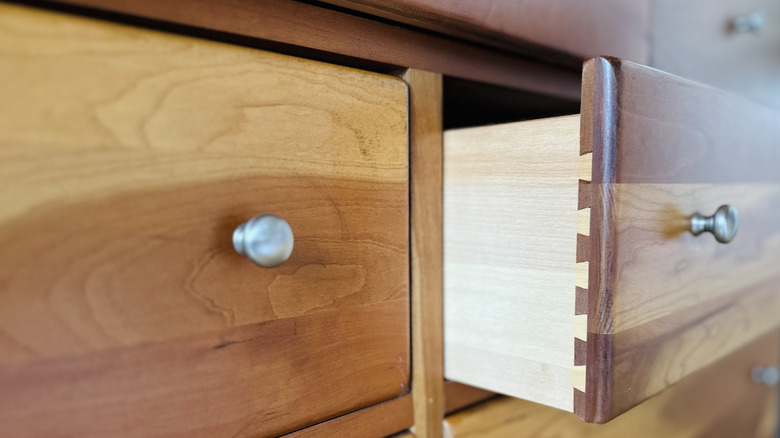How To Identify Fake Vs. Real Solid Wood In Vintage Furniture
Vintage furniture brings a certain charm and history into a home, but the market is full of pieces that are not what they seem. While many sellers claim their items are solid wood, they might actually be made from veneers, particleboard, or other engineered material. Knowing how to tell the difference is important if you want to successfully buy antique furniture. By paying close attention to key details — like grain, weight, edges, joinery, and construction — you can easily and confidently find the real thing amongst the dupes and invest in a piece that will last.
Why does it matter? Well, knowing the difference between solid wood and anything less might help you determine whether your piece is true vintage furniture, whether it is worth the price, and whether it will stand the test of time. Solid wood furniture is super durable and can be easily refinished, repaired, and restored, making it a sustainable and lasting choice.
Solid wood ultimately holds its value better over time and makes for a true heirloom piece. In contrast, furniture made from veneers and particleboard is less durable and more prone to water damage. Plus, deep scratches on veneer can be difficult to repair. Let's walk through a few identification steps you will need to know if you want to ensure that your next vintage find is the real deal.
The main clues: grain, weight, and edges
One of the easiest ways to start your inspection is by examining the wood grain. With veneer, the grain pattern will be consistent across all surfaces. Look at the top of a table or the front of a dresser drawer and then compare it with the sides. If the grain pattern continues in an unbroken, natural flow as it wraps around the corners, it might be solid wood. Grain patterns on veneer and engineered pieces, meanwhile, will often abruptly stop at the edges. This is a result of the veneer being glued onto a core substrate material, such as particleboard.
Another big hint is the furniture's weight. A genuine solid wood dresser or dining table will feel heavy and sturdy, and require effort to move or lift. So, when a piece feels surprisingly light for how big it is, that's a red flag. Watch out for lightweight composites like fiberboard or particleboard; they're often covered with a wood veneer. Additionally, pay close attention to the edges and corners. Solid wood pieces may show a little wear and tear in the form of rounded or slightly chipped edges. Here you can sometimes see if a furnishing uses the same wood throughout its frame. Veneered pieces, on the other hand, will usually have a sharp edge where the veneer meets whatever material is underneath it. If the surface gets worn down, it will usually be easy to see the different underlying material.
Joinery and construction are good tip-offs, too
Looking at how furniture is constructed can also reveal its true nature, especially if you happen to be dealing with some convincing fake wood pieces. Solid wood furniture often utilizes traditional joinery methods that woodworkers used before modern adhesives and fasteners were invented. As you inspect a piece, look for signs of dovetail joints on drawers. These interlocking, trapezoid-shaped pins and tails are a classic hallmark of solid wood furniture construction. Similarly, pegged mortice and tenon joints are common in the frames and legs of chairs and tables.
Furniture pieces made with veneers and engineered wood products typically have a simpler, less durable construction. Look for drawers that are held together with staples, nails, or simple butt joints glued at the corners. Likewise, when you see screw or metal brackets used as the main way of holding joining pieces together, that can be a sign of non-solid wood construction. Look at the undersides and backsides of furniture as well; in solid pieces, you will often see the same wood and finish throughout. Veneered and particleboard furniture will frequently have a different, unfinished material on the bottom or back that reveals the core material. The presence of these tell-tale signs is a great indicator that the piece is not solid wood. If you inspect each piece carefully using each of these clues while shopping, you could walk out of the store with a great piece of wooden furniture that will never go out of style. However, you may want to read up on how to tell what kind of wood your furniture is made of before you buy anything.


